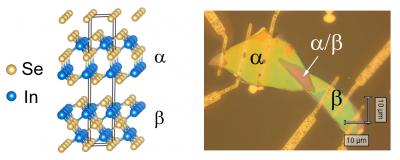Thankfully most countries around the world are now on board with trying to make the world a greener, more safer place to live, and one of the mains ways in which to do that is through the use of alternative energy sources such as solar or hydro power. But what about heat energy? Are we losing a trick there? Washington State University physicist, Yi Gu thinks so and is now working on a device that may one-day turn generated heat into a usable source of energy.

The new device is made up of various components made out of a composite material called a van der Waals Schottky diode. Its role is converting heat into electricity and so far has proven to be nearly three times as efficient as silicon, which is used widely throughout the electronics industry. Eventually, the new diode could revolutionize the industry by providing another source of power to all kinds of products including smartphones and automobiles.
“The ability of our diode to convert heat into electricity is very large compared to other bulk materials used in electronics. In the future, one layer could be attached to something hot like a car exhaust or a computer motor and another to a surface at room temperature. The diode would then use the heat differential between the two surfaces to create an electric current that could be stored in a battery and used when needed,” confirmed Gu.
Schottky diodes are those that are used to direct electricity in one direction and are made by joining a conductor metal such as aluminum to a semiconductor such as silicon. Gu’s diode shies away from this traditional make up and instead is made of a multilayer crystalline Indium Selenide. While one layer’s been heated to act as a metal, another’s been made to act as a semiconductor. Upon closer studying of the diode, the researchers found no defects or impurities where the two materials had been joined and this smooth connection is what enables the electricity to flow through with such ease.
“When you attach a metal to a semiconductor material like silicon to form a Schottky diode, there are always some defects that form at the interface,” confirms WSU physicist and co-author of the study, Matthew McClusky. “These imperfections trap electrons, impeding the flow of electricity. Gu’s diode is unique in that its surface does not appear to have any defects. This lower resistance to the flow of electricity, making the device much more energy efficient.”
Moving forward, Gu and colleagues will be looking into new ways in which they can increase the efficiency of the Indium Selenide crystals as well as seeing how they can produce larger quantities of the material to be used in various applications.
More News to Read
- Meet the Engineer Who 3D Prints Revolutionary Human-Robotic Arms
- Meteor Shower From Dead Comet Sighted Again
- Will Tesla 3 Pre-orders See the Light of Day and Will This Car Create…
- Future NASA Study Will Focus on the Ocean Worlds of the Milky Way
- Quantum Computer Programming: What You Need to Learn to Get Started?

